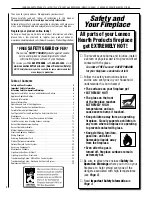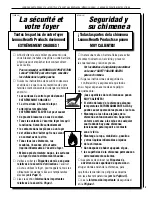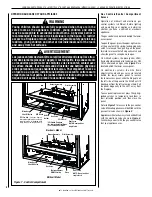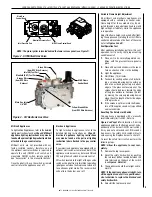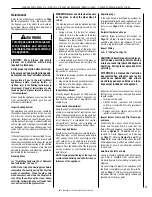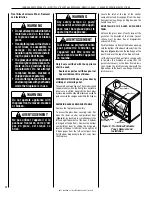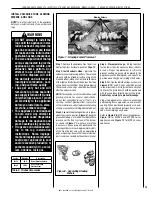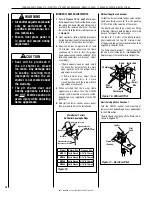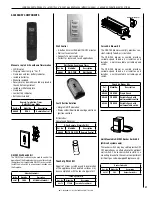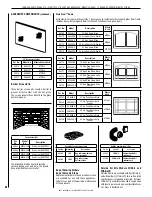
7
NOTE: DIAGRAMS & ILLUSTRATIONS ARE NOT TO SCALE.
LENNOX HEARTH PRODUCTS • MERIT PLUS
®
B-VENT GAS FIREPLACES (MPB33/35/40/45) • CARE AND OPERATION INSTRUCTIONS
NOTICE:
A white film may develop
on the glass enclosure panel during
the first few fires as part of the burn-in
process.
The first few times you use the
fireplace, clean the glass after each use
(
AFTER THE GLASS HAS COMPLETELY
COOLED
); otherwise, the white film
will bake onto the glass and become
difficult to remove.
See glass cleaning instructions on
Page 11
.
Manifold Gas Supply Pressure
Fuel #
Low
High
Natural
Gas
2.2" WC
(0.55 kPa)
3.5" WC
(0.87 kPa)
Propane
6.3" WC
(1.57 kPa)
10.0" WC
(2.49 kPa)
Table 3
Test gauge connections are provided on the
front of the millivolt and electronic gas control
valve (identified IN for the inlet and OUT for the
manifold side). The control valves have a 3/8"
(10mm) NPT thread inlet and outlet side of the
valve (refer to
Figures 2 and 3
)
.
Propane tanks are at pressures that will cause
damage to valve components. Verify that the
tanks have step down regulators to reduce the
pressure to safe levels.
These appliances comply with National Safety
Standards and are tested and listed by OMNI-
Test Laboratories, Inc. (Report No. 116-F-36d-5)
to ANSI Z21.50b-2009 (in Canada, CGA 2.22b-
2009), and CAN/CGA-2.17-M91 (R2009) in
both USA and Canada, as vented gas fireplaces.
The Installation must conform to local codes
or, in the absence of local codes, with the
National Fuel Gas Code, ANSI Z223.1 / NFPA 54
- latest edition, or the Natural Gas and Propane
Installation Code, CAN/CGA B149.1 - latest
edition. The appliance, when installed, must be
electrically grounded in accordance with local
codes or, in the absence of local codes, the latest
edition of the National Electrical Code, ANSI/NFPA
70, or the Canadian Electrical Code,
CGA C22.1 - latest editions.
BTU Input
Millivolt appliances are manually controlled
and feature a spark igniter (piezo) that allows
the appliance pilot gas to be lit without the use
of matches or batteries. This system provides
continued service in the event of a power outage.
Both millivolt and electronic systems can be
operated during a power outage, and feature
manually operated hi-low flame control. The BTU
Input for these appliances is shown in
Table 1.
Input (BTU/HR) Gas Valves
Models
Nat. Gas
Prop. Gas
Input Rate
(BTU/HR
Input Rate
(BTU/HR
MPB33
13,500 to
17,500
13,500 to
17,500
MPB35
16,000 to
20,000
16,500 to
20,000
MPB40
24,000 to
30,000
22,300 to
28,000
MPB45
24,750 to
31,000
23,000 to
29,000
Table 1
Gas Pressure Requirements
Tables 2 and 3
show the appliance inlet and
manifold gas pressure requirements.
Inlet Gas Supply Pressure
Fuel #
Minimum
Maximum
Natural
Gas
4.5" WC
(1.12 kPa)
10.5" WC
(2.62 kPa)
Propane
11.0" WC
(2.74 kPa)
13.0" WC
(3.24 kPa)
Table 2
The appliance and its appliance main gas
valve must be disconnected from the gas
supply piping system during any pressure
testing of that system at test pressures
in
excess of
1/2 psi (3.5 kPa).
The appliance must be isolated from the gas
supply piping system by closing its equipment
shutoff valve during any pressure testing of
the gas supply piping system at test pressures
equal to or less than
1/2 psi (3.5 kPa).
Orifice Sizes - Sea Level to High Altitude
(All Models)
These appliances are tested and approved for
installation at elevations of 0-4500 feet (0-1372
meters) above sea level using the standard
burner orifice sizes (marked with an "*" in
Table
4
)
. For elevations above 4500 feet, contact your
gas supplier or qualified service technician.
Deration -
At higher elevations, the amount
of BTU fuel value delivered must be reduced
by either:
• Using gas that has been derated by the gas
company.
• Changing the burner orifice to a smaller size
as regulated by the local authorities having
jurisdiction and by the (USA) National Fuel
Gas Code NFPA 54/ANSI Z223.1 - latest
edition or, in Canada, the CAN/CGA-B149.1
codes - latest edition.
Install the appliance according to the regulations
of the local authorities having jurisdiction and,
in the USA, the National Fuel Gas Code NFPA
54 / ANSI Z223.1 - latest edition or, in Canada,
the CAN/CGA-B149.1 - latest edition.
Flame breadth, height and width will diminish
4% for every 1,000 feet of altitude.
In Canada - CAN/CGA-2.17-M91 (R2009)
(high altitude):
THE CONVERSION SHALL BE CARRIED
OUT BY A MANUFACTURER’S AUTHO-
RIZED REPRESENTATIVE, IN ACCOR-
DANCE WITH THE REQUIREMENTS OF
THE MANUFACTURER, PROVINCIAL OR
TERRITORIAL AUTHORITIES HAVING
JURISDICTION AND IN ACCORDANCE
WITH THE REQUIREMENTS OF THE
CAN/CGA-B149.1 OR CAN/CGA-B149.2
INSTALLATION CODES.
Burn-in Period
During the first few fires in this appliance there
will be some odor due to the curing of the
paint and burning off of lubricants used in the
manufacturing process. Depending on your
use, the burn-in period may take a few hours
or a few days.
KEEP YOUR HOUSE WELL VENTILATED
DURING THE CURING PROCESS. THE ODOR
AND HAZE EMITTED DURING THE CURING
PROCESS CAN BE QUITE NOTICEABLE AND
MAY SET OFF A SMOKE DETECTOR.
If an optional blower is installed, do not turn it
on during the burn-in period.
Burner Orifice Sizes
Elevation 0-4500 feet ( 0-1372 meters)
Model
Nat.Gas
drill size (inches)
Propane
drill size (inches)
MPB33
#47 (0.0785")*
99K74•
(0.048")*
99K78•
MPB35
#44 (0.086")*
60J80•
#55 (0.052")*
19L52•
MPB40
#38 (0.102")*
99K76•
(0.062")*
21L01•
MPB45
#37 (0.104")*
24M10•
#52 (0.0635")*
37G00•
Table 4
* Standard size installed at factory
• Part /Cat. Number


